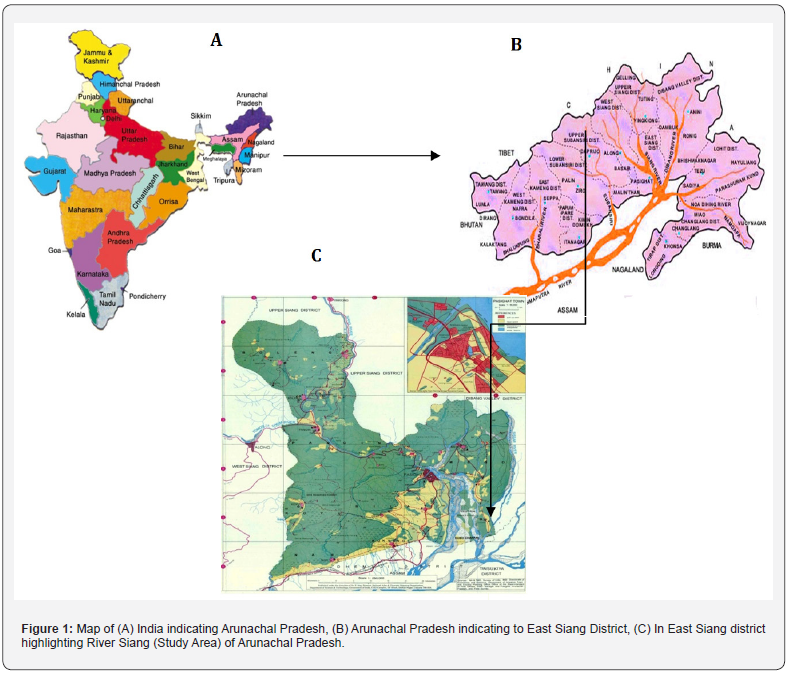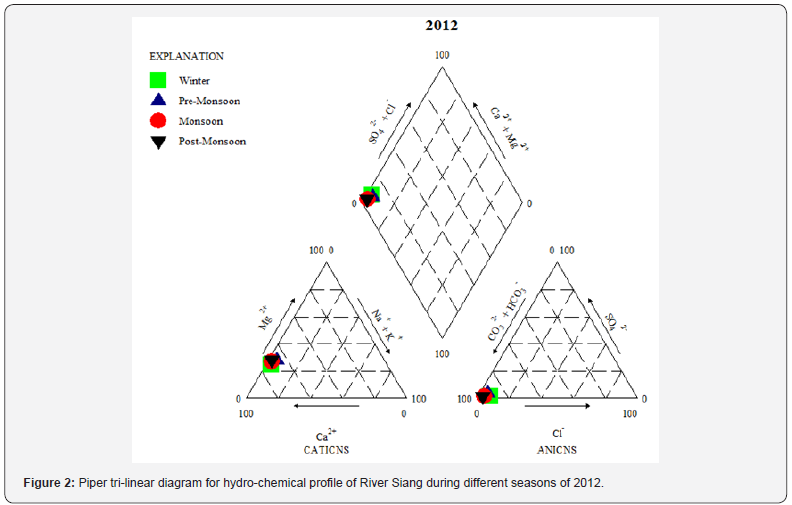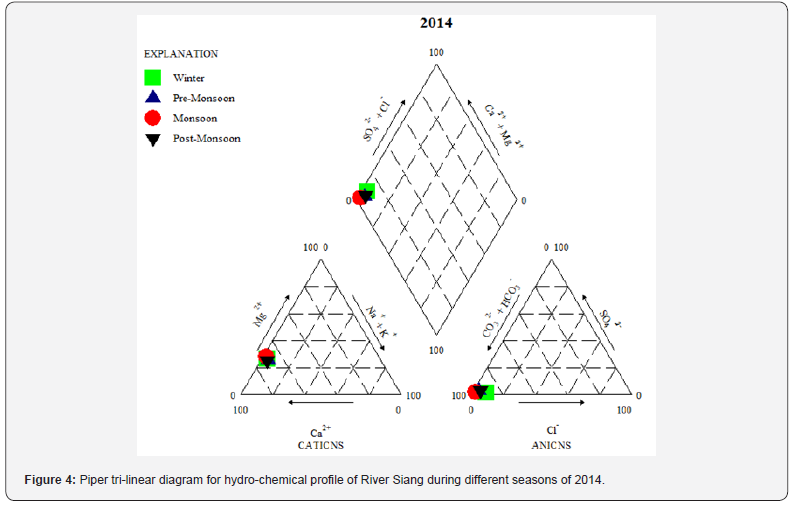Water Analysis of River Siang of Arunachal Pradesh, India
Biplab Kumar Das1* and Devashish Kar2
1Department of Life Science and Bioinformatics, Assam University, India.
2 Department of School of Life Sciences, Assam University, India
Submission: May 05, 2017; Published: July 21, 2017*Corresponding author: Biplab Kumar Das, Department of Life Science and Bioinformatics, Assam University, Silchar- 788011, Assam, India
How to cite this article: Biplab K D, Devashish K. Water Analysis of River Siang of Arunachal Pradesh, India. Fish & Ocean Opj. 2017; 3(5): 555623. DOI: 10.19080/OFOAJ.2017.03.555623
Abstract
Assessments of physico-chemical parameters were carried out during 2012 to 2014. A major and important different water quality parameters were measured in all collected samples, including Water Colour, Air Temperature, Water Temperature, Na+, Ca2++, Mg2+ and Zn3+, Fe3+ and some major anions like Cl-, SO42-, CO32- and SO42-. The results that are recorded in the different stations are compared with the different seasons and also with the different year.
Keywords: Water analysis; Piper; Heavy metal; East siang; Arunachal pradesh
Introduction
Water is the most vital resources for all kinds of life on this planet. Water is one of the nature’s most important gifts to mankind. River Siang is the main river of East Siang district and also it is one of the most important tributary of the mighty River Brahmaputra drainage system. The environment and the ecosystem were badly affected by social, agricultural and industrial activities of human population. River water and ground water were polluted by the growing use of chemicals in the form of fertilizers and pesticides. The ecosystem could be destabilized and could cause ill effects on the health of the human beings as well as all other living organisms [1,2]. The physical and chemical characteristics of any riverine water, sediments play an important role of ecological significance especially in river ecosystem. It reflects the history of the pollution. All type of organic and inorganic solid and liquid matter present in effluent.
Study Site
The River Siang, is largest river of Brahmaputra river system, originates from Chema Yungdung Glacier near Kubi at 5150m in Tibet. In Tibet it is popularly known as Tsang-Po, flows in West–East direction. After traversing a distance of about 1625km river in Tibet and then it takes a turn in south direction, enters the territory of India near Tuting in the Upper Siang district of Arunachal Pradesh and flows through North–South direction in East Siang district towards Assam and finally it merges with Lohit and Dibang in Assam and it becomes the mighty River Brahmaputra [3-5] (Figure 1).
Materials and Methods
Water was collected and stored in clean polyethylene bottles that have been pre washed with de-ionized water. Air temperature, water temperature and pH were determined in the field because of their unstable nature. Water temperature and air temperature were measured with the help of mercury thermometer and pH was measured with pen type pH meter in the field and other parameters was analyzed in the laboratory using standard procedure of APHA [6] and using Perkin Elmer Atomic Absorption Spectrophotometer (AAS) [7].
Results and Discussion
River Siang is Hill-Stream 1st order river; has colluvial (landslide from adjacent hill slopes delivering sediments and organic matter) valley segment and pool-riffle type of reach. This reach type is most commonly associated with small to mid-size streams and is a quite prevalent type of reach in the rheophilic zones. On the other hand, runs are generally laminar flow of water with sandy substratum. Pools, riffles and runs are generally found to dominate the micro-habitat type with frequent occurrence of trench pools. This river is said to be more entrenched based on V-shaped valley segment. The substrate type has been found to be dominated by gravels and cobbles with frequently-occurring quite large number of boulders and some bed rocks [8].
Piper Tri-linear Diagram for hydro-chemical analysis of physico-chemical parameters of River Siang
The relationship(s) of hydro-chemical parameters of the water of River Siang was obtained through Piper tri-linear diagram [9]. This diagram effectively classified the water quality by the distribution of major cations like Na+, Ca2++ and Mg2+ and some major anions like Cl-, SO4 2-, CO3 2- and HCO3 -. This diagram represents the cations and anions composition of samples on a single graph, in which, major groupings or trends in the data could be distinguished visually [10,11].
It consists of geometrical combination of two outer triangles and a middle or inner diamond shaped quadrilateral. The distribution of major cations and anions in mg/l were showed by the left and right and these plotted points in the triangular fields were projected further into the central diamond-like quadrilateral structure, which provides the overall characteristics of the water samples.
The present study on physico-chemical parameters of River Siang revealed that the piper diagrams of water of all the studied seasons were presented in Figure 2, 3 & 4. The major ion chemistry results showed that calcium was the dominant cation and bicarbonate was the major anion in all the studied seasons. The plots from the results revealed that in all the water samples, alkali earth metal elements (Ca2++ and Mg2+) were higher than alkali elements (Na+) and weak acids (CO3 2- and HCO3 -) were higher than the stronger acids (Cl- and SO4 2-). The chemical composition of the study area was influenced by rainfall, climate, rock type, rock division and various human activities [11,12].




Physico-chemical characteristics of surface water varied according to seasons. Most of the water parameters vary seasonally. The specific conductivity was observed moderate during whole studied period; however, it showed a well marked seasonal pattern. The specific conductivity was found to increase during the monsoon and pre-monsoon seasons, and in winter season it was observed as gradual decline of conductivity in River Siang. Nitrates were one of the most important nutrients and had been reported to influence the production of microphytes and macrophytes. Nitrate concentration was also an excellent parameter to judge the organic pollution. In aquatic ecosystems nitrogen level was regulated through geological process, meteorological process and biological process [13].
Nitrate poisoning occurs when fishes were exposed to gradually rising nitrate levels over a period of time. In River Siang, the factors such as ground water inputs, weeds, nitrogen fixation by blue green algae and weeds were absent. Therefore, a very low concentration of nitrate was recorded in the entire stretch of River Siang. The comparatively low concentration of phosphate at upstream of River Siang can be related to low human habitation and lack of agricultural and domestic activities. The minimum values were observed in the monsoon season, due to the accumulation of large amount of rain water diluting the concentration. The values of sulphate were recorded higher in the pre-monsoon season during the whole study period and seasons. All the parameters of sulphate were found within the permissible limit of WHO standard value [14].
Zn was one of the most important trace elements in the body and particulates in the biological function of several proteins and enzymes [15]. Zn can be accumulated via the gills of fishes and the digestive tracks; however the role of water as source of Zn uptake was not fully elucidated [16]. The agriculture run off reaches natural water bodies affecting aquatic species and it turns ecosystem using of large amount of fertilizer of crops. The sources of Zn in waters of River Siang were due from the geological rock weathering or from human activities such as industrial and domestic wastes, water discharges. However, at high concentrations, zinc exerts adverse effect in fish accruing structural damage, which affects the growth, development and survival of fish [17]. The minimum and maximum values of Zn of river Siang was under the permissible limits of WHO standards. Iron (Fe) in water has many effects on aquatic life, both good and bad. Iron comes from various minerals in the soils of river water, which contains the highest iron concentrations. Iron levels in water vary depending on several factors and can affect aquatic populations, behavior and health. The Fe (mg/l) values ranged between 1.05±0.29 to 4.54±1.19, minimum in winter season of 2013 and maximum in monsoon season of 2012.
The study of physico-chemical parameters of River Siang revealed that, the river water free from any pollution and physico-chemical parameters were mostly found to be in the favourable and suitable ranges for the aquatic organisms. If proper measures were taken for the treatment of sewage before discharge and restrictions were out on various anthropogenic activities upstream, the estuary would remain healthy in the long run. The results that were recorded in the different stations and different seasons were compared with the World Health Organization (WHO) and it was found that the water of River Siang may be suitable for drinking and domestic purposes because all the values were between WHO limits.
References
- Kaplan H, Hill K, Lancaster J, Magdalena HA (2000) A theory of human life history evolution: diet, intelligence, and longevity. Evolutionary Anthropology 9(4): 156-185.
- Palavai V (2009) Diversity and distribution of freshwater fishes of the Andaman Islands. Pondicherry University, Ph. D. Thesis, Puducherry, India.
- Das BK, Boruah P, Kar D (2014) Fish diversity and habitat mapping of River Siang in Arunachal Pradesh using Remote Sensing and GIS. In: Mishra GC (Ed.), Innovative Energy Technology Systems and Environmental Concerns: A Sustainable Approach, Research India Publications, New Delhi, India, pp. 13-20.
- Das BK, Boruah P, Kar D (2014) Potential application of Geographic Information System (GIS) and Remote Sensing (RS) in River analysis. International Journal of Recent Scientific Research 5(4): 828-830.
- Das BK, Kar D (2015) Physico-chemical parameters and drainage types of River Siang in Arunachal Pradesh, India. In: Mishra GC (Ed.), Conceptual Framework and Innovations in Agroecology and Food Sciences, Krishi Sanskriti Publications, New Delhi, India, pp. 53-56.
- APHA (2010) Standard Methods for the Examination of Water and Wastewater. American Public Health Association, (16th edn), Washington, USA, p. 1-10.
- Abolude DS, Davies OA, Chia AM (2009) Distribution and concentration of trace elements in Kubanni reservoir in northern Nigeria. Research Journal of Environmental and Earth Sciences 1(2): 39-44.
- Das BK, Kar D (2016) Diversity of Zooplankton in River Siang of Arunachal Pradesh, India. Fish and Ocean Opj 1(2): 1-5.
- Piper AM (1994) A graphic procedure in the geochemical interpretation of water analysis. Trans Am Geophys Union 25(6): 914-928.
- Pradhan B, Pirasteh S (2011) Hydro-chemical analysis of the ground water of the Basaltic catchments: Upper Bhatsai Region, Maharashtra. Open Hydrol Journal 5: 51-57.
- Seth R, Mohan M, Singh P, Singh R, Dobhal R, et al. (2014) Water quality evaluation of Himalayan Rivers of Kumaun region, Uttarakhand, India. Appl Water Sci 6(2): 137-147.
- Cruz JV, Amaral CS (2004) Major ion chemistry of groundwater from perched-water bodies of the Azores (Portugal) volcanic archipelago. Appl Geochem 19: 445-459.
- Toetz DW (1976) Mineral cycling in reservoirs. Ann Okla Acad Sci 5: 21-28.
- WHO (2010) World Health Organization, Guideline for Drinking Water Quality, Geneva, Switzerland.
- Maity S, Roy S, Chaudhury S, Bhattacharya S (2008) Antioxidant responses of the earthworm Lampito mauritii exposed to Pb and Zn contaminated soil. Environ Pollut 151(1): 1-7.
- Spray DJ, Hodson PV, Wood CM (1988) Relative contributions of dietary and waterborne zinc in the rainbow trout, Salmo gairdneri. Can. J Fish Aquat Sci 45(1): 32-41.
- Tuurala H, Soivio A (1982) Structural and circulatory changes in the secondary lamellae of Salmo gaidneri gills to dehydioabietic acid and zinc. Aquat Toxicol 2: 21-29






























